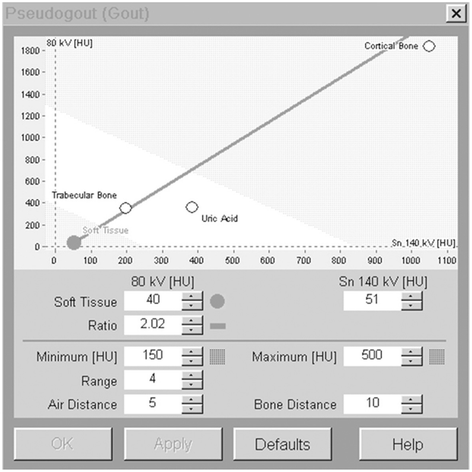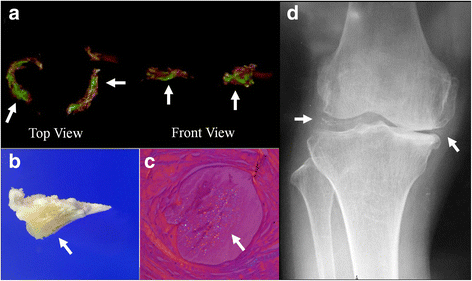Detection of calcium pyrophosphate dihydrate crystals in knee meniscus by dual-energy computed tomography
- PMID: 29622016
- PMCID: PMC5887196
- DOI: 10.1186/s13018-018-0787-0
Detection of calcium pyrophosphate dihydrate crystals in knee meniscus by dual-energy computed tomography
Abstract
Background: Calcium pyrophosphate dihydrate (CPPD) crystals are commonly observed in osteoarthritic joints. The aim of our study was to investigate the efficacy of a dual-energy computed tomography (DECT) for detecting CPPD crystals in knee meniscus.
Methods: Twenty-six patients undergoing primary total knee arthroplasty were included in the study. Radiographs of knee joint and synovial fluid specimens were analyzed for the presence of CPPD crystals. Meniscus extracted during surgery was scanned using DECT. Sensitivity and specificity of DECT and radiograph for detecting CPPD crystals were calculated against a reference standard (polarizing light microscopy of synovial fluid aspirate). Meniscus in which CPPD crystals were suspected with DECT was further examined to confirm the crystals using a polarized microscopy.
Results: CPPD crystals in synovial fluid were observed in 9 (36%) patients. The sensitivity and specificity of DECT in the detection of CPPD crystals, against microscopic identification, were 77.8 and 93.8%, respectively. The sensitivity and specificity of conventional radiography in the detection of CPPD crystals were 44.4 and 100%, respectively. DECT was able to detect the area where CPPD crystals were deposited in the meniscus.
Conclusion: DECT provides good diagnostic sensitivity and specificity for detection of CPPD crystals in knee meniscus as well as spatial information about CPPD crystals. DECT is currently a research tool, but we believe that DECT can be a useful instrument to diagnose CPPD deposition disease, especially for the regions where aspiration is difficult to be performed such as pubic symphysis, atlantoaxial joint, interphalangeal joint.
Keywords: Calcium pyrophosphate; Dual-energy computed tomography; Knee joint meniscus; Pseudogout.
Conflict of interest statement
Ethics approval and consent to participate
This study followed the Declaration of Helsinki and was approved by the local ethics committee of the Saitama City Hospital, Saitama, Japan.
Consent for publication
Not applicable.
Competing interests
The authors declare that they have no competing interests.
Publisher’s Note
Springer Nature remains neutral with regard to jurisdictional claims in published maps and institutional affiliations.
Figures


Similar articles
-
Comparison of characteristics of patients with and without calcium pyrophosphate dihydrate crystal deposition disease who underwent total knee replacement surgery for osteoarthritis.Osteoarthritis Cartilage. 2007 Feb;15(2):232-5. doi: 10.1016/j.joca.2006.08.012. Epub 2006 Oct 10. Osteoarthritis Cartilage. 2007. PMID: 17045495
-
Knee effusion: ultrasound as a useful tool for the detection of calcium pyrophosphate crystals.Clin Rheumatol. 2016 Apr;35(4):1087-91. doi: 10.1007/s10067-015-3100-1. Epub 2015 Oct 21. Clin Rheumatol. 2016. PMID: 26490039
-
The high prevalence of pathologic calcium crystals in pre-operative knees.J Rheumatol. 2002 Mar;29(3):570-4. J Rheumatol. 2002. PMID: 11908575
-
Imaging of chondrocalcinosis: calcium pyrophosphate dihydrate (CPPD) crystal deposition disease -- imaging of common sites of involvement.Clin Exp Rheumatol. 2012 Jan-Feb;30(1):118-25. Epub 2012 Mar 7. Clin Exp Rheumatol. 2012. PMID: 22325558 Review.
-
Calcium pyrophosphate deposition disease: clinical manifestations.Reumatismo. 2012 Jan 19;63(4):246-52. doi: 10.4081/reumatismo.2011.246. Reumatismo. 2012. PMID: 22303531 Review.
Cited by
-
Diagnostic advances in synovial fluid analysis and radiographic identification for crystalline arthritis.Curr Opin Rheumatol. 2019 Mar;31(2):134-143. doi: 10.1097/BOR.0000000000000582. Curr Opin Rheumatol. 2019. PMID: 30601230 Free PMC article. Review.
-
Calcium pyrophosphate crystal size and characteristics.Osteoarthr Cartil Open. 2021 Mar;3(1):100133. doi: 10.1016/j.ocarto.2020.100133. Epub 2021 Jan 6. Osteoarthr Cartil Open. 2021. PMID: 34386778 Free PMC article.
-
Imaging and management of calcium pyrophosphate deposition disease.Skeletal Radiol. 2025 Jan 8:10.1007/s00256-024-04859-1. doi: 10.1007/s00256-024-04859-1. Online ahead of print. Skeletal Radiol. 2025. PMID: 39775910 Review.
-
Chondrocalcinosis does not affect functional outcome and prosthesis survival in patients after total or unicompartmental knee arthroplasty: a systematic review.Knee Surg Sports Traumatol Arthrosc. 2022 Mar;30(3):1039-1049. doi: 10.1007/s00167-021-06519-6. Epub 2021 Mar 6. Knee Surg Sports Traumatol Arthrosc. 2022. PMID: 33677614 Free PMC article.
-
A critical review of the available evidence on the diagnosis and clinical features of CPPD: do we really need imaging?Clin Rheumatol. 2021 Jul;40(7):2581-2592. doi: 10.1007/s10067-020-05516-3. Epub 2020 Nov 24. Clin Rheumatol. 2021. PMID: 33231775 Review.
References
Publication types
MeSH terms
Substances
LinkOut - more resources
Full Text Sources
Other Literature Sources

